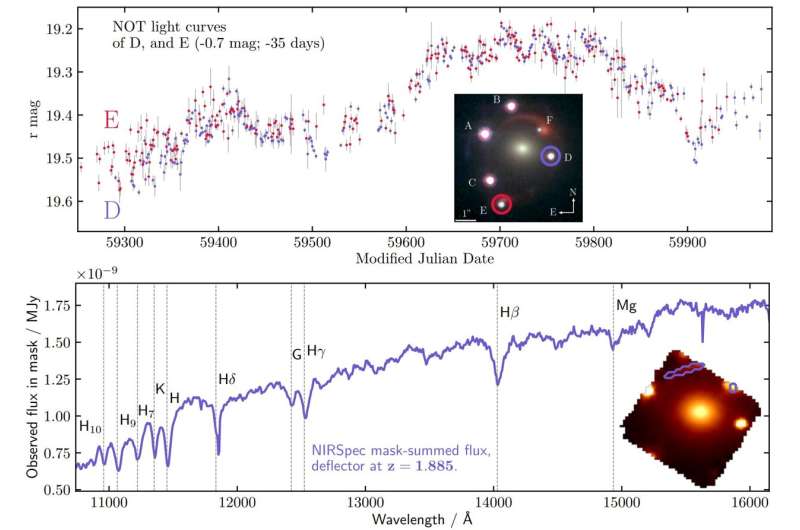
An international team of astronomers has discovered an instance of two galaxies aligned in a way where their gravity acts as a compound lens. The group has written a paper describing the findings and posted it on the arXiv preprint server.
Prior research has led to many findings of galaxies, or clusters of them, bending light in ways that were predicted by Einstein’s theory of general relativity. Astronomers have noted that some of them work as imperfect lenses, distorting the light behind them in interesting ways.
Some researchers have also noted that elliptical galaxies can serve as a lens, serving to brighten the light behind them. In this new effort, the research team has found, for the first time, two galaxies that align in a way that allows their gravity to work as a compound lens.
A compound lens, as its name suggests, is made up of two lenses. Those made artificially are cemented together and work to correct each other’s dispersion. In the astronomical case, a compound lens can be made by the dual effects of two galaxies lined up next to one another just right.
The researchers note that when the system, J1721+8842, was first discovered, it was believed that there was just one elliptical galaxy bending the light from a quasar behind it. In analyzing data over a two-year period, the researchers of this new effort found variations in the quasar imagery. They also found small bits of light that, at first glance, appeared to be duplicates from a single source.
A closer look revealed that they matched the light from the main quartet of lights—a finding that showed that all six bits of light were from the same source. Prior research had suggested such an image could be the result of a natural compound lens.
When adding data from the James Webb Space Telescope, the team found that a reddish ring that was mixed with the other lights and was thought to be an Einstein ring was, in reality, a second lensing galaxy. The researchers next built a computer model and used it to confirm that the observation they had made was indeed that of a compound lens.
The research team expects the finding will allow other researchers to more precisely calculate the Hubble constant, perhaps leading to a resolution of conflict over its actual value.
More information:
F. Dux et al, J1721+8842: The first Einstein zig-zag lens, arXiv (2024). DOI: 10.48550/arxiv.2411.04177
Journal information:
arXiv
© 2024 Science X Network
Astronomers discover two galaxies aligned in a way where their gravity acts as a compound lens (2024, November 15)
retrieved 15 November 2024
from https://phys.org/news/2024-11-astronomers-galaxies-aligned-gravity-compound.html
part may be reproduced without the written permission. The content is provided for information purposes only.